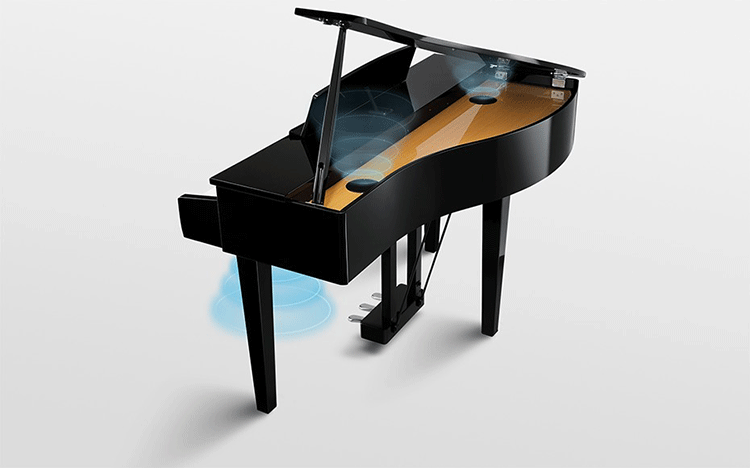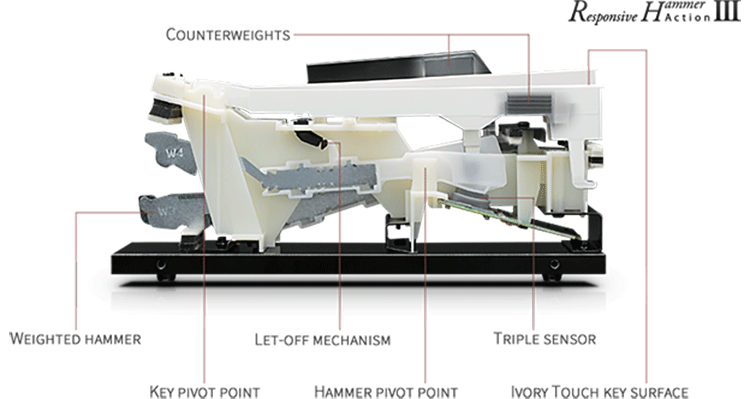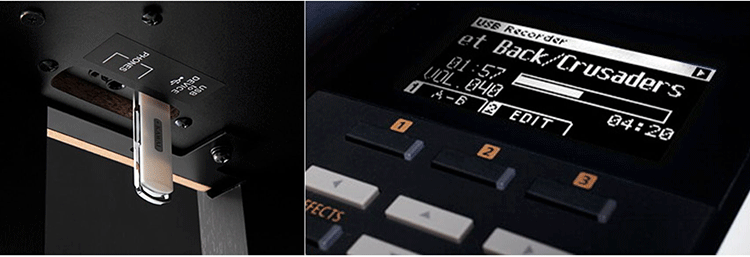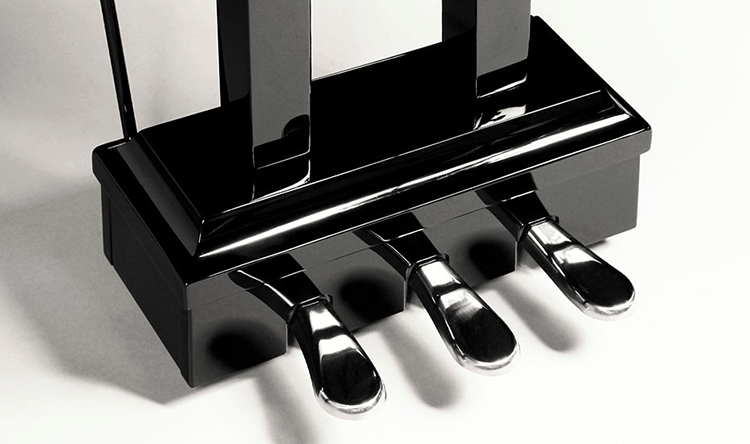Finally, an affordable digital grand piano from Kawai. If there was one glaring hole in Kawai’s otherwise strong digital piano lineup, it was without question a digital baby grand piano that didn’t totally break the bank like previous models like the CP1.
And the fact is, there’s a real demand for products like this – just look at the success of Roland’s GP line. Kawai has finally answered the bell and plugged this hole with the brand new Kawai DG30.
That means it’s time for a review. We’re going to jump right into our dissection of this new instrument to see if it matches expectations and how it measures up to other options in the market. Be sure to check out the accompanying video as well for an even more in-depth analysis and some playing examples.
Kawai DG30 Digital Grand Piano – General Overview

Why is this a Big Deal?
We first heard about the new DG30 back during NAMM 2020. We, and many other dealers, have been begging Kawai for something like this for years, so naturally, we were very excited to see to learn that the DG30 was on the way.
We knew there was going to be a serious market for this piano, and given Kawai’s track record, we were sure they would be able to produce an excellent instrument for this category.
First Impressions of the Specs Sheet
When we finally got our hands on the specifications sheet we were in all honesty a little bit underwhelmed. The specs sheet just didn’t have the wow fact of a Kawai NOVUS 10 or NOVUS 5 for example.
Now that we’ve finally had a chance to play one and disregard some of our previous expectations, the overwhelming consensus is that this is a very satisfying piano to play that also happenns to look great.
Attractive Cabinet
And this shouldn’t be a surprise as the DG30 is essentially a Kawai CN39 in the piano cabinet of a small grand piano – the same sound engine, speakers, keyboard action, etc. The CN39 is a wonderful instrument in its own right, so despite our lack of initial enthusiasm for fancy new specs, we’re perfectly fine with Kawai’s choice here.
With that out of the way, let’s dive into the piano sound.
Kawai DG30 – Piano Sound

4 Speaker System With 2x 20 Watt Amps from Onkyo
To start, the DG30 has a pair of 20-watt amplifiers for a total of 40 watts of power, coming at the player through a 4 speaker system. There are two main speakers aimed at the floor, and two tweeters for some of the higher frequencies.
Onkyo Audio Technologies was a big contributor here as the speaker/amp configuration was designed in concert with them, and they have supplied the signal processing technology.
Progressive Harmonic Imaging Sound Engine
It features the Progressive Harmonic Imaging (PHI) sound chip with 88-key stereo sampling, which as mentioned, is the same version found in the CN39, as well as the CA49. The focus of this sample set is the beautifully recorded Shigeru Kawai SK-EX concert grand piano.

The 88-key stereo sampling is significant as it means each and every note of the SKEX was recorded individually as opposed to only recording one in every four or five notes and stretching the sample. Individual note sampling produces a far more accurate tone.
Other Sounds
There are 355 built-in sounds, and the vast majority of these are high-quality. The acoustic pianos and vintage electric pianos are definitely the highlights.
That said, Kawai always has nice church organs and as a result, their digital pianos have been quite popular with the worship community for many years. The Kawai DG30 would make for a fine digital piano for a Church looking for a versatile digital piano that happens to look like an acoustic baby grand.
OLED Display User Interface
Navigating the controls is the same as on the CN39 as well, with an easy-to-use control panel with an OLED display located on the cheek block.
256 Note Polyphony
The polyphony is a strong 256 notes which might sound like overkill, but it will be important to some as you can have 16 MIDI tracks going in at once on this thing.
A large polyphony count like this also ensures that even if you’re layering and adding effects, the polyphony is never going to get strained.
Virtual Technician
The Kawai DG30 is also equipped with Kawai’s Virtual Technician feature, which gives the player access to 19 editable sound-related parameters.
If that’s too intimidating, there are several Smart Presets that give you specific combinations of the parameters pre-determined by Kawai. Check out the video for some examples of this, as well as some playing examples of the different grand piano sounds.
Cabinet Resonance
Some final observations related to sound; despite the sound specs lining up exactly with the CN39, we are noticing an effect the cabinet seems to be having on the sound, namely, there’s some real cabinet resonance coming through. This isn’t in the marketing literature, but we’re definitely picking up on it.
On to the piano action.
Kawai DG30 – Piano Action
Responsive Hammer III Key Action

The Kawai DG30 is equipped with Kawai’s Responsive Hammer III action. Though they’ve kept the name the same, this is the latest, upgraded version of the RHIII.
This action is known for being one of the best plastic key actions available and features grade-weighted hammers, ivory touch white key surfaces, let-off simulation, triple sensor key detection, and counterweights.
The dynamic output is very accurate, as is the weighting. The texture on the key surfaces offers a nice balance between grip and glide, and the white keys are rounded for ease of piano playing experience.
The Best Plastic Key Action Available?
There’s not much more one could really ask for with this action – it’s responsive, offers the player a ton of control, and the repetition speed is good. In fact, many people consider the RHIII to be the best plastic action currently on the market.
Roland’s PHA4 often gets considered as well, but it doesn’t have the counterweights or the repetition speed that the RHIII does.
You need to jump to a wood-based action for a real upgrade from here, but to keep the price down on the DG30, Kawai elected for this action as opposed to the wood-based Grand Feel Compact.
Kawai DG30 – Connectivity

Connector Ports
Let’s start with the physical connector ports. The Kawai DG30 has both 1/4” stereo line inputs and line outputs. This is really important because if you’re looking for the aesthetics of a baby grand piano for a venue, such as a restaurant or other performance space, but would like something maintenance-free, the DG30 is going to be a great choice.
1/4” stereo line outputs ensure you can connect the DG30 to an amp or external speaker system for more power than what the 40-watt amps can muster.
After that, we’ve got dual headphone jacks, as well as USB Type A and B connectors.
Bluetooth MIDI & Bluetooth Audio
The Kawai DG30 also has Bluetooth MIDI and Bluetooth Audio. Bluetooth MIDI means you can connect to Smart devices to access apps like Kawai’s Sound Museum apps and playback recordings, while Bluetooth Audio means you can stream music directly through the DG30’s sound system.
This makes the DG30 a wonderful piano for entertaining – who won’t be impressed hearing high-quality audio coming from your grand piano at your next party?
Kawai DG30 – Features
Internal Recorder
The Kawai DG30 is a strong internal song recorder that can record both WAV and MP3 files, and you can save up to 16-Track standard MIDI recordings to a flash drive.
This might not be the most relevant feature to the average DG30 buyer, but it’s a nice perk that carries over from the CN39.
Metronome & Other Functions
In terms of other features, the DG30 has pretty much everything else you’d expect, such as a metronome, transpose, built-in rhythms, and a built-in lesson function. There’s a variety of built-in lesson books too such as Alfred Lesson Songs, Czerny, Chopin, and more.
Kawai DG30 – High-End Cabinet

Genuine Polyester
Now to the cabinet. Kawai went all the way here by using genuine polyester for the Ebony Polish finish, as they do with their acoustic grand pianos. This is worth noting because not every piano company uses real polyester for their ebony polish finishes, and instead, often takes a much less durable approach.
Polyester does make the instrument heavier, but two people would still be able to move it, so keep that in mind if you’re a restaurant owner looking to spice up your establishment.
Full Appointments
Rounding out the cabinet is an attractive key cover, music rest, and a 2-position top board for an even more aesthetic effect.
Grand Feel Pedal System

Lastly, we have to mention that the DG30 is using Kawai’s Grand Feel Pedal System with half-pedal support, which is something pianists just love. Kawai has applied three different spring pressures to the three pedals – Damper, Sostenuto, and Soft- mimicking the exact feel of a grand piano pedal system.
Closing Thoughts
Thank you for sticking with us at Merriam Music Blogs and Articles through this review of the DG30. We’re thrilled that Kawai has added this to their lineup. The Kawai DG30 is going to compete really nicely against Roland’s GP-607, and in fact, we have a comparison video between the two that you can check out here.
The Kawai DG30 is a competitively priced, musical, and perhaps most importantly, beautiful digital grand piano from Kawai ready for a variety of settings. And with Kawai’s great reputation and warranty coverage, you can feel confident going with the DG30 rather than some no-name branded digital piano from a big box store.

